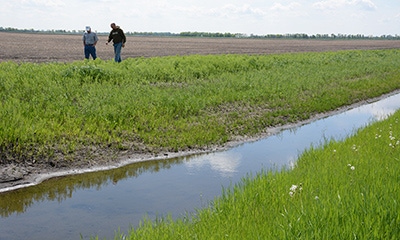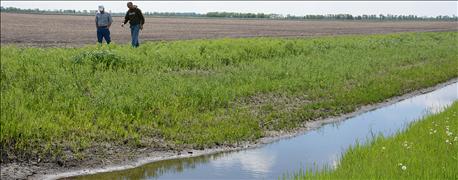
After listening to concern expressed by legislators, Gov. Mark Dayton ordered the Department of Natural Resources Jan. 29 to stop mapping private ditches that the agency believed were included under the state’s new buffer legislation.
The agency had expected to finish the buffer protection maps by July.
Dayton, in a press release, said he issued the order with “with great reluctance” and acknowledged that some legislators insist that private ditches were not included in the scope of the legislation.

Governor halts DNR buffer mapping
Dayton also alluded to threats he heard that would have impacted bonding requests for the DNR and the Board of Water and Soil Resources that would address serious water quality and infrastructure challenges if private ditches were not retroactively exempted from the new buffer requirement.
“I will not put at risk the water quality improvements in my bonding proposal and other critical bonding measures over this dispute,” he said, adding that he was “deeply disappointed by this.”
Dayton singled out House Republican leadership in his press release as the cause for the “fierce opposition.”
Rep. Paul Torkelson (R-Hanska), in a press statement, said he met with Dayton and expressed concerns about the DNR’s misinterpretation of Minnesota's buffer law.
"Last fall, it became clear the DNR was misinterpreting the new law and greatly expanding its scope to include private ditches, so House Republicans and Senate Democrats began working with the Dayton administration to ensure that legislative intent was followed," Torkelson said. "We are pleased the governor has agreed to uphold the legislative intent of the new buffer law, supported by House Republicans and Senate Democrats."
Under an agreement reached by the House, Senate and Governor Dayton last year, by November of 2018 buffers of 16.5 feet must be installed on all public ditches.
Farm leaders who were involved in the buffer discussions maintain that private ditches were never part of the proposed legislation.
~~~PAGE_BREAK_HERE~~~
Following Dayton’s announcement, four farm group presidents sent the governor a joint letter voicing support for his action and acknowledging that it would expedite the mapping process and allow farmers, local governments and county Soil and Water Conservation Districts to work on implementation of the new law.
“We strongly encourage the expedited release of the buffer protection maps by DNR in order to facilitate the implementation process,” the letter said. “The components of data are well-established quantities and available for incorporation to the buffer protection map. There should be no delay in finalizing this process.”
The letter offered the governor a recap of what farmers currently do to protect water resources, such as proper tillage and nutrient practices based on conditions, and employing various structural practices such as tile drainage, terraces, grass waterways and buffers to manage excess water.
Presidents of the Minnesota Farmers Union, the Minnesota Farm Bureau, Minnesota Corn Growers and Minnesota Soybean Growers signed the letter. They also invited Dayton to visit farms to see practices first-hand.
“You will find that while there is still room for improvement, a lot of good work is already underway,” the letter noted.
Ongoing concern
This was not the first letter sent to the governor by farm leaders. Last December, presidents of MFU, MFB, MCGA, MSGA, the Minnesota Association of Wheat Growers and the Red River Valley Sugarbeet Growers Association sent a letter to Dayton explaining their concern about overreach by DNR and BWSR in buffer mapping. And at the annual DNR roundtable meeting Jan. 15 in Brooklyn Center, attendees heard a presentation on buffer mapping and how LiDAR would be used on entire watersheds, using DNR criteria to establish digital versions of ditches, said Doug Busselman, Minnesota Farm Bureau public policy director.
Criteria, as listed in the DNR roundtable presentation available online, talk about staying with the water quality purpose of the law; allowing for local control to guide map and follow-up; being fair and equitable among landowners; and developing criteria to minimize need for dispute resolution.
The fourth item—minimizing the need for dispute resolution—contained sub-criteria yet to be finalized. Those sub-criteria listed were bed and banks; connections to downstream public waters; within benefitted areas of 103E drainage systems; and altered or artificial channels.
Thom Peterson, Minnesota Farmers Union government relations director, says MFU supports Dayton’s current action and ongoing meetings.
“We’re willing to have a discussion going forward about how to address runoff from private land,” Peterson says. “There was some discussion about mapping private ditches to show landowners that might be interested in doing some additional buffering once they started with public [ditches], but it was our understanding this would not be mandated.”
About the Author(s)
You May Also Like






